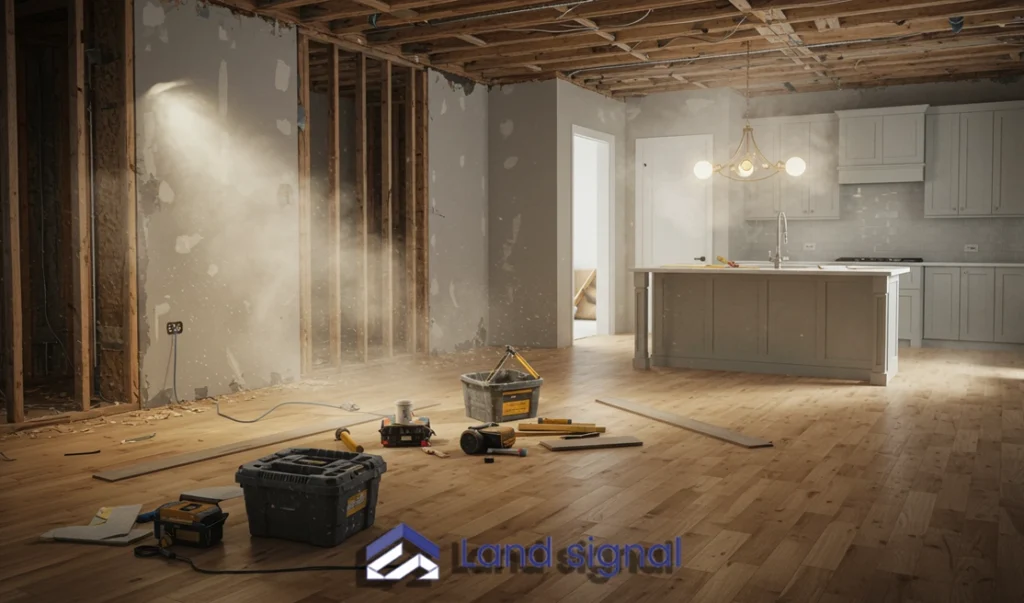Embarking on a home renovation in the dynamic Toronto market is often envisioned as a value-adding, transformative process. However, the path from concept to completion is paved with potential technical and financial pitfalls. A successful project is not a matter of chance but the direct result of meticulous, informed planning. Missteps in this process can rapidly escalate a dream investment into a complex liability.
This guide of Land Signal provides a technical roadmap for navigating the most critical challenges, ensuring your project is built on a foundation of strategic foresight rather than costly afterthoughts.
Start Your Project with Confidence
At Land Signal, we assist with construction and renovation permits, as well as Garden House and Laneway Suite designs. Let our experts guide you through every step.
The Pre-Planning Fallacy
One of the most profound errors in property renovation is succumbing to the temptation of immediate action. Newly acquiring a property and instantly commissioning a redesign bypasses a crucial diagnostic phase: inhabitation.
Living within a space is the only true method for understanding its inherent flaws and functional rhythm—its response to natural light, its daily traffic patterns, and its subtle spatial shortcomings.
Making decisions based on an initial walkthrough often leads to trend-driven choices that fail to serve the long-term, practical needs of the occupants. To truly define your project’s scope and avoid reactionary decisions, it’s vital to ask a series of foundational questions before any walls come down:
- How does sunlight travel through the home at different times of the day and year?
- Which areas experience the most foot traffic, and are they configured to support it?
- Where are the existing functional bottlenecks in daily routines (e.g., kitchen workflow, bathroom access)?
- What are the non-negotiable needs of the inhabitants versus the “nice-to-have” features?
Financial Foresight Failure
In a high-cost construction market like the Greater Toronto Area, a superficial budget is an immediate red flag. A realistic financial plan extends far beyond the quoted costs of materials and labor.
The most frequently overlooked component is a dedicated contingency fund, which should be, at minimum, 15-20% of the total project cost. This is not simply a buffer for overages; it is a calculated provision for the specific, high-probability risks inherent in renovating older housing stock.
Navigating these financial unknowns is key to avoiding one of the most stressful Home Renovation Mistakes to Avoid. This budget must account for several common yet costly discoveries, including:
Common Hidden Costs
- Asbestos and Hazardous Material Abatement: Discovery often necessitates specialized, expensive removal services.
- Outdated Electrical and Plumbing: Bringing systems up to the current Ontario Building Code standards can be a significant unbudgeted expense.
- Latent Structural Deficiencies: Uncovering compromised joists, foundational cracks, or water damage after demolition begins.
- Municipal Permit and Inspection Fees: These administrative costs are often underestimated or forgotten in initial calculations.
Read Also: Renovation Cost Calculator Toronto
The Bylaw Blindspot
Navigating the complex web of municipal regulations is arguably the most high-stakes element of any renovation project in Toronto. Proceeding without the correct permits is not a calculated risk; it is a guarantee of future complications.
The consequences range from stop-work orders and significant fines to a legal mandate to demolish the unpermitted work entirely. Furthermore, unpermitted renovations create serious disclosure issues and can derail a future property sale.
Understanding whether your project—be it a basement conversion, a home addition, or a structural alteration—complies with local zoning bylaws is a non-negotiable first step. It’s here that overcoming potential Home Renovation Mistakes to Avoid requires specialized expertise.
Your Strategic Partner in Compliance
For homeowners, investors, and even small contractors, deciphering these regulations is a formidable task. This is the precise challenge Land Signal is designed to solve. As an online platform specializing in zoning bylaws in Toronto and the process of home building permit Toronto, Land Signal provides end-to-end support, from interpreting complex municipal codes for a legal basement conversion to managing the entire permit application for a second floor addition Toronto. We transform regulatory hurdles into a clear, manageable process.
Read Also: Renovation Permit Toronto | Everything You Need to Know Before You Build
The Contractor Selection Gamble
The selection of a general contractor represents a critical pivot point for any project. Opting for the lowest bid without rigorous due diligence is a dangerous gamble that often leads to substandard workmanship, schedule overruns, and contractual disputes.
A professional contractor is not a commodity but a project partner whose expertise should protect your investment. The vetting process must be treated with the same seriousness as the financial planning. The allure of a bid that comes in significantly lower than all others is powerful, but it’s critical to analyze what that lower number truly represents. It often doesn’t signal efficiency; it signals omission.
A dramatically low price may reflect an absence of essential line items: adequate insurance, contingency planning, a budget for quality materials, or even a basic understanding of the project’s full scope. This is the core of the gamble: you are betting your investment against the high probability of change orders, substandard work, or project abandonment once those unquoted costs inevitably surface. To move from a gamble to a calculated business decision, your selection process should be systematic. We recommend using a thorough checklist to vet every potential contractor:
- Licensing and Insurance: Is the contractor licensed to work in your municipality and do they carry both liability insurance and WSIB coverage?
- Portfolio and References: Can they provide a portfolio of comparable projects and a list of recent clients you can contact directly?
- Detailed Written Quote: Does the quote break down costs for labour, materials, and subcontracting, or is it a vague lump sum?
- Formal Contract: Is a standard, detailed contract used that outlines payment schedules, timelines, scope of work, and dispute resolution?
Ignoring Unseen Systems
A critical technical error is viewing a home as a collection of independent parts rather than a single, integrated system. This is one of the more subtle but impactful Home Renovation Mistakes to Avoid.
Focusing purely on aesthetic upgrades while neglecting the underlying building science—the “unseen” systems—can compromise the home’s performance and durability, especially in the demanding Toronto climate.
Consider a tangible example of this systemic failure: a homeowner installs a powerful, modern kitchen range hood for ventilation—a seemingly isolated upgrade. However, in an airtight home, this new fan can create negative pressure, pulling air from the easiest available source.
This may cause dangerous back-drafting from fuel-burning appliances like the furnace or water heater, drawing carbon monoxide into the living space. This single, well-intentioned change, made without considering the home’s overall pressure balance, turns an upgrade into a significant safety hazard, perfectly illustrating why a systemic view is not optional, but essential. A holistic approach becomes critical when you consider two specific areas:
Ventilation and Air Quality
Modern renovations often create more airtight envelopes. Without a corresponding mechanical ventilation strategy (like an HRV/ERV system), indoor pollutants and humidity can become concentrated, impacting both the health of the occupants and the structure itself.
Energy Efficiency Integration
Changes must work in concert. Adding insulation to the attic is less effective if the walls are poorly insulated or if there are significant air leaks around windows and doors. A true energy audit should inform where upgrades will deliver the highest return.
Unearthing Latent Liabilities
The moment of demolition is often the moment of truth. Walls, ceilings, and floors can conceal a host of problems that no initial inspection could reveal. These “latent liabilities” are what the contingency fund is truly for.
Discovering extensive rot, termite damage, or crumbling cast-iron plumbing can instantly halt a project and inflate its budget dramatically. Acknowledging this possibility from the outset is a mark of a well-planned project.
While every home is unique, a number of latent issues appear with regularity during major renovations. Be prepared for the possibility of unearthing:
- Hidden mold colonies behind drywall or in ceilings.
- Structural beams or joists improperly cut by previous owners.
- Undisclosed knob-and-tube wiring requiring a full electrical overhaul.
- Deteriorated or leaking plumbing stacks within walls.
- Cracked foundations hidden behind finished basement walls.
The Aesthetics Versus Endurance Trap
A common budget-cutting temptation is to sacrifice long-term material quality for short-term visual appeal. This trap involves selecting trendy, low-cost finishes for high-use areas, a decision that almost invariably leads to premature wear, tear, and replacement costs.
The smarter investment prioritizes durability and function in the elements that endure the most daily stress. Establishing a proper balance here is fundamental to avoiding some of the most frustrating Home Renovation Mistakes to Avoid.
A wise renovation budget allocates more to functional hardware and high-traffic surfaces. The trade-off between a fleeting trend and a durable classic is best illustrated with a direct comparison:
| Component | Trendy but Low-Quality Option | Timeless and High-Endurance Alternative |
| Kitchen Countertop | Thin laminate or low-grade solid surface that scratches and stains easily. | Quartz or granite, known for superior resistance to heat, scratches, and staining. |
| Flooring | Inexpensive vinyl plank or laminate with a thin wear layer that peels or dents. | Engineered hardwood or high-quality porcelain tile designed for decades of use. |
Conclusion
Ultimately, a successful home renovation is a function of diligent, front-loaded intellectual work, not superior spending or good luck. The most consequential Home Renovation Mistakes to Avoid all stem from a failure to prioritize strategic planning, thorough vetting, and regulatory compliance. By approaching your project as a technical and financial undertaking first, you create the conditions for a seamless and rewarding transformation. To ensure your first step is on solid ground, contact Land Signal to navigate Toronto’s complex permit and zoning landscape with confidence.






